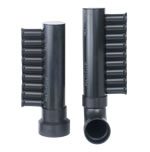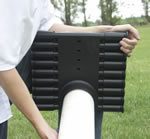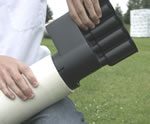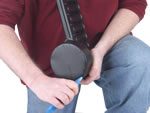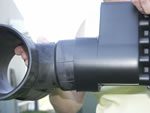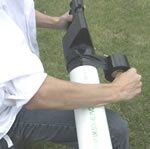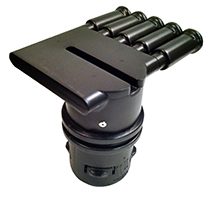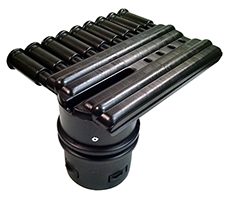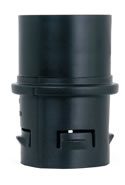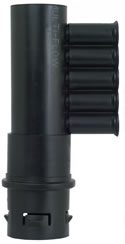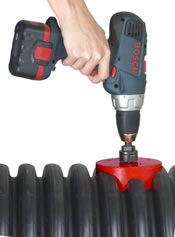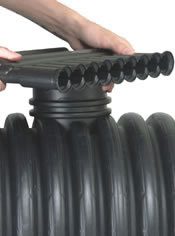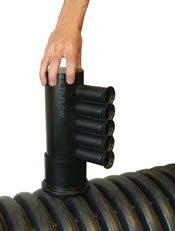FAQ
Questions we are asked about appropriate use
Why is drainage so important for healthy grass?
Why not just use a traditional French drain?
How does Multi-Flow compare to other products with a similar shape?
Why is drainage needed under synthetic turf?
What is the link between drainage and West Nile Virus?
How heavy a load can Multi-Flow bear?
Just how does artificial drainage work?
Questions we are asked about installation
Why Narrow Trench Installation Technology (NTIT™)?
What kind of equipment is needed to install a Multi-Flow system?
How wide a trench is required?
How deep should the trench be?
Should the trench be lined with a fabric?
What should be done with the water after it has been collected?
What are the requirements of a transport system?
How does Multi-Flow connect to round pipe?
How can Multi-Flow collector lines tap into a rigid pipe transport system?
How can Multi-Flow collector lines tap into a corrugated pipe transport system?
What if the transport pipe is substantially lower than the collector system?
Can I insert an inspection port?
What is to be done when there is a sidewalk, patio, or other obstruction in the path?
Will Multi-Flow work effectively where there is little or no grade?
How can I install multiple levels of Multi-Flow?
What should be used to backfill the trench?
If the recommended backfill medium is not available, should another drainage system be selected?
Can Multi-Flow be installed horizontally?
Should rain gutters be attached to a Multi-Flow system?
Other questions we occasionally hear
What sizes does Multi-Flow come in?
What lengths does Multi-Flow come in?
Is a Multi-Flow system something a homeowner can install or is a contractor required?
Where can I find the closest installer?
Does Varicore provide design assistance?
Is it possible to over drain?
Will backfill choices affect Multi-Flow’s warranty?
Will cold temperatures affect Multi-Flow’s performance?
Is a Multi-Flow system compatible with natural, sustainable or green landscapes?
How do I get hold of a free product sample?
Does Varicore make any suggestions about the drainage of my site?
Drainage Applications
[B] Baseball Field Drainage, Basement Drainage, Bike Path Drainage, Bocce Court Drainage, Boulevard Drainage, Bunker Drainage
[C] Campground Drainage, Cart Path Drainage, Cemetery Drainage, Commercial Drainage, Concert Site Drainage, Construction Site Drainage
[D] Desaturation Project Drainage, Driveway Drainage
[E] Earthen Dam Drainage
[F] Fairway Drainage, Flower Garden Drainage, Football Field Drainage
[G] Golf Course Drainage, Golf Green Drainage, Green Landscape Drainage, Greenhouse Drainage
[H] Highway Drainage, Horse Paddock Drainage
[J] Jogging Path Drainage
[L] Landfill Site Drainage, Landscape Drainage, Lawn Bowling Green Drainage, Leach Pile Drainage
[M] Mine Drainage
[N] Nursery Drainage
[O] Open Play Area Drainage, Orchard Drainage
[P] Parking Lot Drainage, Pasture Drainage, Paver Drainage, Playground Drainage
[R] Railroad Drainage, Rail Yard Drainage, Residential Drainage, Retaining Wall Drainage, Rough Drainage, Runway Drainage
[S] Soccer Field Drainage
Questions we are asked about appropriate use
Why is drainage so important for healthy grass?
Walking on, maintaining, or driving over soil that is saturated will compact the soil by forcing suspended soil particles into air voids. This will make the surface hard and uneven as well as inhibiting healthy plant growth. Soil that is saturated or lacking in voids will not yield healthy grass.
(See also Is it possible to over drain?)
Why not just use a traditional French drain?
Multi-Flow is a modified and improved French drain. Multi-Flow, employing Narrow Trench Installation Technology (NTIT™), has several important advantages over an old-fashioned French drain:
Extended life of the drainage system. Coarse sand will dramatically extend the life of any filter wrapped drainage system. However, it is very difficult to replicate the sand filter when constructing an old-fashioned French drain. Because of this, French drains routinely decrease in efficiency until they blind altogether, often within a few years. It is easy to surround Multi-Flow with very coarse sand backfill.
Less surface disruption. In renovation settings, there is a huge advantage in using the small equipment required in installing the Multi-Flow system rather than the large equipment used to construct a conventional French drain.
Cost. The Multi-Flow system requires only a 4-inch trench. This saves on the cost of excavation and backfill bringing the overall cost down well below that of other French drains.
More discussion about French Drains
More discussion about NTIT
How does Multi-Flow compare to other products with a similar shape?
Frequently we are asked what advantages Multi-Flow has over other panel-shaped drains. We will share some of the more obvious differences. We encourage you to check out the information provided by other manufacturers on their web sites to compare for yourself.
We would like to point out four Multi-Flow advantages.
- Superior Flow Rates –Multi-Flow products are capable of carrying water away at about twice the rate of would-be rivals. Flow rates for Multi-Flow’s 6-inch products are generally comparable or superior to the 12-inch products of other panel drains.
- Functional Connectors – The Multi-Flow system provides simple effective ways to connect Multi-Flow components to other Multi-Flow components as well as connections to corrugated or rigid pipe. Other panel shaped systems provide a very limited selection of connectors and many of these appear to be second-rate at best. These manufacturers are reluctant to show their fittings on-line.
- Integral Flow Channels – Most panel drains consist of posts or cuspates wrapped in filter. They may have the appearance of egg cartons wrapped in cloth. Water is supposed to flow between the posts or cusps. These flow areas are dramatically reduced in size when, due to intrusion and compaction, the filter is forced into interspatial areas . Multi-Flow has enclosed flow channels which are not susceptible to the same problem.
- Uniform Strength – Pillar type panel drains measure their strength applying perpendicular pressures. Under such conditions they yield results similar to Multi-Flow. They do not respond nearly so well when diagonal pressures are applied. In real world situations, however, pressure is seldom from an exclusively perpendicular direction. Multi-Flow exhibits strength, regardless of the direction of the pressure.
Why is drainage needed under synthetic turf?
Competition in the synthetic turf field construction business has become very intense. This has resulted in pressure to cut engineering corners. Some designers have even omitted drainage systems from their designs in an effort to further reduce costs. The shortsightedness of this strategy is not always immediately visible.
Typical synthetic turf installations position the turf over a layer of stone aggregate (frequently two to three layers of stone aggregate, increasing in size from top to bottom) which in turn rests on a dense clay base separated by a geotextile liner. Water landing on the turf soon seeps through to the clay. From there it slowly moves toward a collector trench where an under drain collects it and carries it away. The stone aggregate is capable of holding large amounts of water. Seldom does a field receive so much rainfall that it exceeds the holding capacity of the stone and water begins ponding on the surface.
However, if the water is allowed to remain on the clay base for extended periods of time, the base begins to disintegrate. A saturated clay base will retain less than half of its original load bearing strength. As the foundation loses its structural integrity, the surface sags, bows and ripples. A drainage system located on the geotextile liner provides the water a rapid avenue of escape, thereby protecting the vital base from saturation. The durability of a synthetic turf field depends on an excellent under drain.
A Multi-Flow drainage system provides this excellent under turf drainage. Because of its shape it need not be trenched. It is also strong enough to avoid collapse and provides excellent flow rates.
What is the link between drainage and West Nile Virus?
West Nile Virus is the most common mosquito borne disease in the U.S. Last year 9,862 cases were documented – 720 in Texas alone.
According to the Center for Disease Control web site:
Even one bite can transmit West Nile Virus or other diseases. While you’re enjoying the outdoors, remember:
- Eliminate mosquito breeding sites.
- Use mosquito repellent.
- Install or repair screens.
- Support community-based mosquito control programs.
Of course Multi-Flow isn’t about to deliver mosquito repellent or repair your screens but it certainly can help establish a mosquito-free environment. By providing an escape route for standing water in and around backyards, athletic fields, golf courses, playgrounds, horse paddocks, etc., Multi-Flow eliminates the breeding grounds mosquitoes need in which to multiply. Water should not be allowed to stand in stagnant puddles for more than two days. Responsible and effective drainage should be the first line of defense in the war against West Nile Virus and other insect borne diseases.
can help establish a mosquito-free environment. By providing an escape route for standing water in and around backyards, athletic fields, golf courses, playgrounds, horse paddocks, etc., Multi-Flow eliminates the breeding grounds mosquitoes need in which to multiply. Water should not be allowed to stand in stagnant puddles for more than two days. Responsible and effective drainage should be the first line of defense in the war against West Nile Virus and other insect borne diseases.
How heavy a load can Multi-Flow bear?
Multi-Flow will deflect only 20% when a force of 6,000 pounds per square foot is applied, but there will be no change in its water flow properties. In other words, you can apply 6,000 lbs/sq/ft of force and still expect a full flow from the system. Multi-Flow has been tested to 10,000 lbs/sq/ft where it demonstrated ovaling, but no significant reduction in rate of flow.
Just how does artificial drainage work?
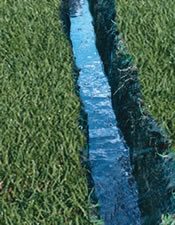 The open trench is the most basic model for an artificial drainage system. |
Artificial drainage Artificial drainage is the removal and relocation of excess soil water. Once soil has reached the point where it is holding all the water that it is capable of holding, additional water from rain or irrigation will pond on the surface or flow to a lower point. A drainage system provides a passageway for excess water to escape through as it leaves the saturated area.Consider the open trench For the most basic model of a drainage system, picture for a moment a field that is crisscrossed by narrow trenches. Water from neighboring saturated soils or from puddles on the surface will seep into these trenches and flow from the area. Drainage products hold the walls of the trench open while allowing the surface to be covered.Gravity rules! Like natural drainage systems, artificial drainage systems rely on gravity. They cannot draw water “uphill.” Therefore, drainage systems are dependent on continuous natural or created slope. Water flows to a lower point whenever a lower point is available. |
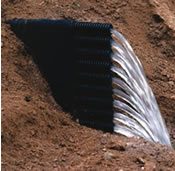 Multi-Flow provides you with the most effective collector system. |
Collection and transport Modern artificial drainage systems are comprised of:
Multi-Flow is the preferred collector system while smooth, rigid pipe provides the most reliable transport system. When planning the layout of Multi-Flow collector lines, consider these factors:
|
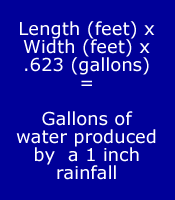 |
|
Questions we are asked about installation
Why Narrow Trench Installation Technology (NTIT™)?
NTIT™ is the most significant innovation in drainage technology since the advent of plastic pipe. It was developed in response to dissatisfaction with the failure rate and labor intensity of traditional French drains. This drainage philosophy combines convenience and efficiency to generate a better result.
NTIT™ assumes that a drainage system will be minimally disruptive, display an expanded surface area, exhibit a generous flow capacity, and have a long life expectancy.
minimal surface disruption— NTIT™ requires the drainage medium to exhibit a narrow profile requiring less trench width.
expanded surface area – The drainage medium is not only narrow but also tall resulting in far more surface area than traditional round pipe. More surface area provides more opportunity for water to enter the flow channels, thereby increasing drainage efficiency.
generous flow capacity — NTIT™ requires that the drainage medium contain unobstructed round flow channels for the rapid removal of collected water.
long life expectancy – Perhaps the most important feature of NTIT™ is its longevity. A tall thin drainage medium in a narrow trench can easily be backfilled with sand. Sand is an excellent filter. By preventing clay and silt from reaching the geotextile filter of the drainage product sand dramatically extends the life of the drainage system.
What kind of equipment is needed to install a Multi-Flow system?
Typically a 4 inch wide chain trencher is used to dig the trenches required for the installation of Multi-Flow. Ancillary equipment might be shovels, utility vehicles, wheelbarrows etc. No heavy construction machinery is usually required in the actual installation process. For larger projects, Great Lakes Inter-Drain, Inc. makes a lightweight tractor trencher that collects the excavated material. The AFT 45 is ideal for remedial work on athletic fields or golf courses.
How wide a trench is required?
A minimum 4 inch wide trench is recommended. This allows for approximately 1.5 inches of sand filter on either side of the drainage product.
How deep should the trench be?
Trench depth varies with the application; however as a rule of thumb the trench should be as deep as the desired water level. In many near surface applications, only the top several inches of soil needs to be desaturated. In this case the top of the Multi-Flow product will be placed 2 to 6 inches from the surface.
Should the trench be lined with a fabric?
No, Multi-Flow comes ready to drop into an open trench. Do not use any additional fabric to line the trench. This would expose the Multi-Flow system to the same risks French Drains face.
What should be done with the water after it has been collected?
Prior to designing a drainage system an adequate location for the outlet must be established. Examples might be city storm drains, a ditch or other low-lying area, or in some cases even the city streets. There may be situations were there is no alternative but to use a dry well. Dry wells are basically a void in the earth sometimes filled with large rock. Because they have a somewhat fixed capacity, dry wells are a last choice as an outlet location for a drainage system. If a pump is being used to transfer the collected water, calculate the maximum volume of water. (Length X Width X .623)
What are the requirements of a transport system?
Transport systems need to be able to carry water away from the site as fast as the collector system can accumulate it. Furthermore, the transport system must be at least as strong as the collector system. PVC, ABS, and dual wall corrugated HDPE pipe are good options.
Flow rate requirements will vary depending on the number of collector lines that are being fed into a given transport pipe. 6-inch, 12-inch, and 18-inch Multi-Flow collectors are capable of delivering 17, 29, or 45 gallons per minute, respectively. Multiply the number of collector lines times the appropriate gpm to determine the maximum expected rate.
Designing transport systems for athletic fields
Designing transport systems for golf courses
Designing transport systems for horizontal landscape installations
Designing transport systems for vertical landscape installations
How does Multi-Flow connect to round pipe?
Customers attach Multi-Flow to a wide variety of round pipes. Corrugated single wall, corrugated double wall, PVC, ABS, Schedule 10, Schedule 40, Schedule 80, straight pipe, pipe with bell, flanges, etc. Obviously Multi-Flow will attach differently to each.
There are a number of options for converting Multi-Flow to round pipe.
How can Multi-Flow collector lines tap into a rigid pipe transport system?
| There are a variety of ways that a rigid transport pipe can be tapped. The use of in-line tees and saddle tees are common methods. Multi-Flow manufactures the Rigi-Tap connector made especially for this purpose. The Rigi-Tap allows for a convenient transition from a Multi-Flow multi-purpose connector (such as a 0600M) to a PVC pipe. This is a cost effective and time saving method for converting from a Multi-Flow collection system to any rigid pipe transport system. It is an attractive alternative to expensive and time consuming in-line tees. The 08RTP provides connection to an 8-inch PVC while the 10RTP connects to a 10-inch PVC. Connections to other diameters are available by special order. |
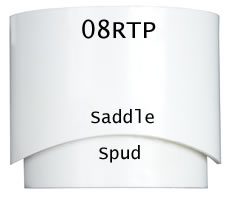 |
|
| Instructions for installation:
|
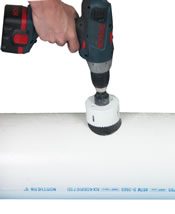 A 3.5 inch hole saw produces a clean snug hole. 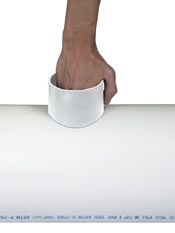 Rotate the Rigi-Tap until all surfaces are in contact. |
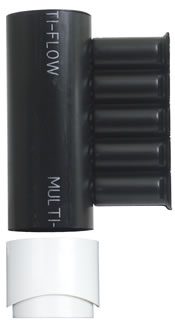 Do not attach the Rigi-Tap to a Multi-Flow connector until the cement is firmly set. |
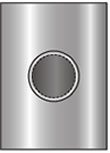 |
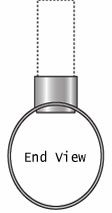 |
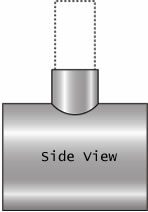 |
How can Multi-Flow collector lines tap into a corrugated pipe transport system?
| As with rigid pipe, there are a variety of ways that a corrugated transport pipe can be tapped. The use of in-line tees and saddle tees are common methods. Varicore manufactures the Corru-Tap connector made especially for this purpose. Before explaining that method, a word of caution is in order. Varicore strongly encourages the use of PVC pipe for a transport system due to its strength. Corrugated pipe, especially the single wall version, does not possess the crush resistance of the Multi-Flow collectors. It would be unwise to engineer for strength in the collection system and settle for weakness in the transport system. Dual wall corrugated pipe is less risky.
Having said that, we know that there are times when a corrugated transport system is already in place or it has been specified on a project. With that in mind, the Multi-Flow Corru-Tap provides a cost effective and time saving method for converting from a Multi-Flow collection system to a corrugated transport system. When Multi-Flow is installed horizontally, such as under synthetic turf, a 06023 or 12023 is used. This is far superior, on the one hand, to the common practice of simply emptying the collector lines into a rock filled trench allowing it to find its own way into the perforated transport. It is far easier than installing a tee in the transport line. The 00CTV will connect to any Multi-Flow multi-purpose connector and is usually used in vertical situations. This vertical Corru-Tap connects to any Multi-Flow multi-purpose connector. An extension can be used if the transport is located at a much lower elevation. Corru-Taps provide a soil tight, but not water tight, fit. Since it is entering a perforated pipe, a water tight fit is unnecessary. The Corru-Tap is typically suitable for 8 to 18-inch dual wall pipe. Instructions for installation 1. Select and mark the center of the correct spot on the top of the transport pipe to install the Corru-Tap. 2. For a soil tight fit, cut a clean hole in the pipe using a hole saw. Use a 3 7/8 -inch hole saw for 06CTH and 00CTV Taps or a 4 7/8 -inch hole saw for a 12CTH. 3. Insert the Corru-Tap into the hole until the locking tabs engage. 4. In horizontal applications, Multi-Flow pipe is connected directly into the Corru-Tap. In vertical applications, the Corru-Tap will receive any multi-purpose connector or a pipe extension. |
|
||||||||
|
|
What if the transport pipe is substantially lower than the collector system?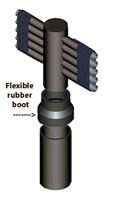
A PVC riser pipe can be connected to the bottom of any multi-purpose connector. The length of this riser is indeterminate. In situations where settling is anticipated, a flexible rubber boot is recommended. The rubber boot will provide flexibility in the event of shifting above or below.
Can I insert an inspection port?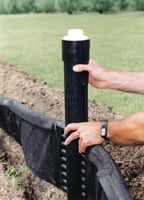
Inspection ports can be installed above any multi-purpose connector. A 3” Female Adapter with Plug, Part #ABS01, connects to the multi-purpose connector using a piece of 3-inch PVC the length required to reach the surface. Inspection ports could be used to flush a system, to monitor water flow, to mark line locations, or more commonly, to satisfy curiosity.
What is to be done when there is a sidewalk, patio, or other obstruction in the path?
Assuming it is not possible to cut through the obstacle, Multi-Flow can be connected to an end outlet, connected to a short piece of round pipe that runs under the object, and then connected back to another end outlet which is attached to the continuing line of Multi-Flow.
Will Multi-Flow work effectively where there is little or no grade?
Artificial drainage makes use of gravity to relocate unwanted water. Gravity pulls the water down the grade, the length of the trench (drainage system) to the outlet. If the trench does not slope downward to one end, then water will only move after it builds up in the trench, and it will move much more slowly than it would if there were slope to the trench. It is advisable to maintain .5% to 1% minimum slope in the drainage system. (.0005 – .001 gradient or 6 to 12 inches of fall for each 100 feet of length)
How can I install multiple levels of Multi-Flow?
Multi-purpose outlets and connectors (e.g. 1200M and 12009 can be coupled together using a 3” to 3” couple (ABS05) In larger volumes, Varicore can custom manufacture connectors to accommodate multiple lifts. Multiple lifts are sometimes needed in highway drainage along steep slopes, behind retaining walls, and in other specialty settings.
What should be used to backfill the trench?
Selection of a suitable backfill medium is critical for the proper performance and longevity of any drainage system. The backfill medium serves as a primary filter to screen out silt and clay that might eventually clog the drainage system.
Fine and very fine sand may slow down the inflow of water and may even pass through the filter. Larger aggregates, on the other hand, will not do an adequate job of filtering.
“Very coarse sand” is recommended as backfill medium for drainage products. According to the USDA system of classification, very coarse sand has an approximate particle size of between 1.0 and 2.0 mm.
When passed over sieves very coarse sand will have:
-
- less than 5% retained on a #10 U S standard sieve
- less than 5% passing a # 30 U S standard sieve
- No more than 1 % pass through a # 50 U S standard sieve
Should it be necessary to deviate from this recommended backfill material due to lack of availability or other constraints placed upon the drainage system design, a reduction in the life of the drainage system can be anticipated.
A more complete discussion about selecting backfill can be found in the engineering section.
If the recommended backfill medium is not available, should another drainage system be selected?
Obviously we would not want to see installers backfill Multi-Flow, or any other drainage product for that matter, with native soil. The system would quite likely suffer premature failure. The customer might then blame the drainage product instead of the real culprit, the fines, for that failure.
The backfill recommendation above is not exclusive to Multi-Flow drain products, but is a practical guideline for any drainage system design where silts or fines are present, and longevity of the system is desired. Experienced drain installers agree that backfilling with native soil or poor sand is a dangerous practice.
We know that sometimes customers must settle for less than the very best. Any kind of select backfill is to be preferred over the native excavated soil. Multi-Flow’s size and shape makes premium backfill a more realistic possibility than in a French drain system. However, that is only one of many attractive Multi-Flow features. Superior strength, increased surface area, faster flow rates, better quality filter, professional and speedy service, and an unparalleled connector system all combine to put Multi-Flow head and shoulders above the competition with or without the very best backfill. It would be unfortunate if someone chose to install an inferior drainage product because of the illusion that it could be safely backfilled with inferior backfill.
Can Multi-Flow be installed horizontally?
For certain special applications it may be advisable to install Multi-Flow in a horizontal orientation. Examples might be: golf course greens, synthetic turf athletic fields, playgrounds, and larger planter boxes. There are several connectors made specifically for this type of installation: the 6-inch Horizontal Double Wye (06016, the 6-inch Horizontal Cross (06018), the 12-inch Horizontal 90 degree (1201N), the 12-inch Horizontal Tee (12017), and the 12-inch Horizontal Cross (12018). The Multi-Purpose single sided coupler (0600M, 1200M, and 1800M) and several other standard connectors can also be used in this type of application. Installers must pay special attention to maintaining a fall of elevation when installing horizontally.
Should rain gutters be attached to a Multi-Flow system?
Great care has been taken to prevent silts and other fines from entering the Multi-Flow drainage system. Water emitted from rain gutters often contains foreign material that is unwanted in a drainage system. Rain gutters should be connected to a solid PVC pipe and directed away from the structure. Many times Multi-Flow can also have its outflow connected to the same PVC pipe. Not only might roof debris block the system, but excessive roof water might be deposited against the footings or basement walls.
Other questions we occasionally hear
What sizes does Multi-Flow come in?
Multi-Flow comes in three sizes: 6-inch, 12-inch, 18-inch nominal heights. (Actual heights are 6.75”,12.15”, and 18.9”) All three have a width of approximately 1.25 inches.
What lengths does Multi-Flow come in?
Multi-Flow comes in 150-foot rolls. The 150-foot rolls are shipped via common carriers to your job site.
Is a Multi-Flow system something a homeowner can install or is a contractor required?
Many homeowners do choose to install their own drainage system. The homeowner’s time and ability along with the scope of the job will determine whether it is appropriate to call a contractor.
If the homeowner decides to install the Multi-Flow, it will require the right tools and supplies, such as a trencher, a method to measure grade, sand, and shovels. A “Ditch Witch” or “Dingo” type trencher can usually be rented from a local rental for $20-$25 per hour. A laser level is also useful and can be rented for about $25 for half a day.
Where can I find the closest installer?
Any qualified drainage contractor can install Multi-Flow. For smaller jobs, irrigation or landscape contractors may be a better choice because the Multi-Flow system does not require any of the heavy earth moving equipment usually associated with drainage. Varicore has compiled a list of experienced contractors. It may contain a contractor in your area. The list is contained in the attached PDF.
Contractor List PDF
Does Varicore provide design assistance?
Varicore can provide drainage pattern drawings made specifically for your site. We also assist customers with material take-offs and performance estimates from those drawings. These are not official construction drawings. Because we cannot typically be on site to measure elevations etc., drawings will not contain such information. These drawings are provided to customers without charge for use in planning and budgeting.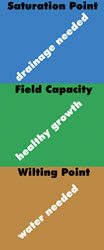
Is it possible to over drain?
Drainage cannot and will not remove all water from the soil. It only reduces it from an unacceptable “saturation point” to the desired level of “field capacity.” At this point, water clings to surrounding soil particles which refuse to yield any more moisture to gravity. In situations where there is grass or other plants, these plants can still access this remaining soil water. Due to plant usage, combined with evaporation, soil moisture levels will eventually fall to a “wilting point” at which time additional water becomes mandatory.
Will backfill choices affect Multi-Flow’s warranty?
Multi-Flow’s warranty is not affected by backfill choices. Varicore Technologies guarantees that each roll of pipe leaving our factory meets the high standard laid out on our product specification sheet. Choice of backfill and installation techniques will in no way affect this warranty. Varicore manufactures the highest quality drainage products. So, it encourages the end user to insist on installation practices that insure the longest possible life and the highest level of performance from the drainage system.
Will cold temperatures affect Multi-Flow’s performance?
The core of the Multi-Flow product is made of high density polyethylene, a material that is much more resilient than PVC or other materials when dealing with expansion associated with frost. There have been no problems related to cold temperatures associated with Multi-Flow. As with any drain system, if water is trapped in the system, it can freeze up with ground frost restricting flow until it thaws. With multiple passageways, it is unlikely that water will stand in all of the tubes. Installing with a continual gradual fall is the best insurance against such an event.
Is a Multi-Flow system compatible with natural, sustainable or green landscapes?
Green landscaping or greenscapes are evidence of a strong trend in the landscaping industry. These landscapes are creative, aesthetically pleasing and environmentally sensitive. They contain few, if any, mowed areas; utilize more native plants; and generally provide extensive shade. These areas usually require at least some artificial drainage. Urban areas frequently are left with dense, difficult-to-drain soils. It is impossible to establish and maintain a variety of native plants in wet or saturated areas. Furthermore, soil water management is an essential tool in preventing soil erosion. Saturated soils are prone to destabilization and movement.
Ideally, water that is collected on-site should be used on-site. This is often accomplished by establishing ponds and other water features and by using collected water for irrigation and other outdoor uses.
Multi-Flow is an ideal drainage product for use in green landscapes for at least three reasons:
- Multi-Flow can be installed with minimal disruption to surrounding landscape features. This is especially helpful within the cozy confines of greenscapes.
- A Multi-Flow system will provide longevity. This is important because as the green landscape becomes well established, replacement of the drain system becomes increasingly difficult and expensive.
- A Multi-Flow system will provide prompt and effective drainage.
How do I get hold of a free product sample?
We will send you a small section of our 6-inch Multi-Flow upon your request. Call, fax or e-mail us and we’ll send one your way. For large projects, samples of other products are available as well.
Does Varicore make any suggestions about the drainage of my site?
Athletic Field Drainage
- Engineering/Design Assistance/athletic fields
- Installation/athletic fields
- Engineering/CAD Downloads
- Applications/athletic fields
- Projects/athletic fields
- FAQS/Why is drainage needed under synthetic turf ?
- Model Specifications/athletic fields
- Engineering/CAD Downloads/Baseball diamond
- Projects/athletic fields/ SBC Park
- Projects/athletic fields/Alvin Community College
- Projects/athletic fields/Loyola Academy
- Projects/athletic fields/Hamilton Sports Fields
- Engineering/Design Assistance/athletic fields
- Installation/athletic fields
- Applications/athletic fields
Basement Drainage
- Projects/residential/Willmar
- Engineering/CAD Downloads/foundation
- Engineering/Design Assistance/landscapes
- Applications/residential
- Installation/landscaping
Bike Path Drainage
- Applications/recreational areas
- Engineering/CAD Downloads/turf to pavement
- Design Assistance/paved surfaces
- Installation/paved surface
Bocce Courts Drainage
- Applications/athletic fields
- FAQS/Why is drainage so important for healthy grass?
Boulevard Drainage
- Engineering/CAD Downloads/median
- Projects/Commercial/Sims Creek
- Projects/paved surfaces/City of Auburn
Bunker Drainage
- Engineering/CAD Downloads/bunker
- Engineering/Design Assistance/golf courses
- Installation/golf courses
Campground Drainage
1. Applications/recreational areas
Cart Path Drainage
- Engineering/CAD Downloads/cart path
- Engineering/Design Assistance/golf courses
- Installation/golf courses
- Engineering/CAD Downloads/turf to pavement
Cemetery Drainage
1. Applications/commercial
2. Installation/landscapes
Commercial Drainage
1. Applications/commercial
2. Projects/commercial
3. Installation/landscapes
Concert Site Drainage
1. Applications/recreational areas
Construction Site Drainage
1. Applications/commercial
2. Applications/civil
3. Engineering/CAD Downloads/details
Desaturation Projects
1. Projects/civil/Poplar Island
2. Applications/civil
Driveway Drainage
1. Engineering/CAD Downloads/turf to pavement
2. Applications/paved surfaces
3. Projects/paved surfaces
4. Design Assistance/paved surfaces
5. Installation/paved surface
Earthen Dam Drainage
1. Applications/civil
Equestrian Center Drainage
1. Applications/recreational areas
2. installation/landscapes
Fairway Drainage
1. Engineering/Design Assistance/golf courses
2. Engineering/CAD Downloads/details
3. Installation/golf courses
4. Applications/golf courses
5. Projects/golf courses/Spyglass
6. Projects/golf courses/Eagle Creek
7. Projects/golf courses/Carnmoney
8. Projects/golf courses/Stony Creek
Flower Garden Drainage
1. Applications/residential
2. Installation/landscapes
Football Field Drainage
- Engineering/CAD Downloads
- Projects/athletic fields/ American River
- Projects/athletic fields/Rockford
- Projects/athletic fields/St. John’s
- Projects/athletic fields/Loyola Academy
- Projects/athletic fields/Hamilton Sports Fields
- Engineering/Design Assistance/athletic fields
- Installation/athletic fields
- Applications/Athletic fields
Golf Course Drainage
1. Engineering/Design Assistance/Golf Courses
2. Engineering/CAD Downloads/details
3. Installation/golf courses
4. Applications/golf courses
5. Projects/golf courses
Golf Green Drainage
1. Engineering/Design Assistance/golf courses
2. Engineering/CAD Downloads/details
3. Installation/golf courses
4. Applications/golf courses
5. Projects/golf courses/Shaganappi
Green Landscape Drainage
1. FAQ’s/Compatibility
2. Applications/residential
3. Installation/landscapes
4. Engineering/Design Assistance/landscapes
Greenhouse Drainage
1. Applications/horticulture
2. Engineering/Design Assistance/landscapes
3. Installation/landscapes
Highway Drainage
1. Design Assistance/paved surfaces
2. Installation/paved surface
3. Engineering/Model Specifications/paved surfaces
4. Application/paved surfaces
5. Projects/paved surfaces/City of Auburn
6. Projects/paved surfaces/Nova Scotia
7. Projects/paved surfaces/County Road #1
Horse Paddock Drainage
1. Applications/recreational areas
2. Installation/landscapes
Jogging Path Drainage
1. Applications/ recreational areas
Landfill Site Drainage
1. Applications/civil
Landscape Drainage
1. Engineering/Design Assistance/landscapes
2. Installation/landscapes
Lawn Bowling Green Drainage
1. Applications/athletic fields
Leach Pile Drainage
1. Applications/civil
Mine Drainage
1. Applications/civil
Nursery Drainage
1.Applications/horticultural
Open Play Area Drainage
1. Applications/athletic fields
Orchard Drainage
1. Applications/horticultural
Parking Lot Drainage
1. Design Assistance/paved surfaces
2. Installation/paved surface
3. Projects/paved surfaces/parking lot
4. Applications/paved surfaces
5. Engineering/CAD Downloads/under pavement
Pasture Drainage
1. Applications/recreational drainage
Paver Drainage
- Engineering/CAD Downloads/horizontal
- Installation/landscapes/horizontal applications
- Engineering/Design Assistance/landscapes/horizontal installations
Playground Drainage
- Applications/recreational drainage
- Projects/recreational/Central
- Engineering/Design Assistance/landscapes/horizontal applications
- Installation/landscapes/horizontal applications
Railroad Drainage
1. Engineering/Design Assistance/railroads
2. Applications/civil
Rail Yard Drainage
1. Applications/civil
Residential Drainage
1. Applications/residential
2. Projects/residential
3. Engineering/Design Assistance/landscapes
4. Installation/landscapes
5. Engineering/CAD Downloads/details
Retaining Wall Drainage
1. Engineering/CAD Downloads/retaining wall
2. Engineering/Design Assistance/landscapes
3. Installation/landscapes
Rough Drainage
1. Applications/golf courses
2. Installation/golf courses
3. Engineering/Design Assistance/golf courses
Runway Drainage
1. Applications/civil
2. Design Assistance/paved surfaces
3. Installation/paved surface
Soccer Field Drainage
- Engineering/CAD Downloads/soccer field
- Projects/athletic fields/ Esther Shriner
- Projects/athletic fields/Loyola Academy
- Projects/athletic fields/Hamilton Sports Fields
- Engineering/Design Assistance/athletic fields
- Installation/athletic fields
- Applications/athletic fields

